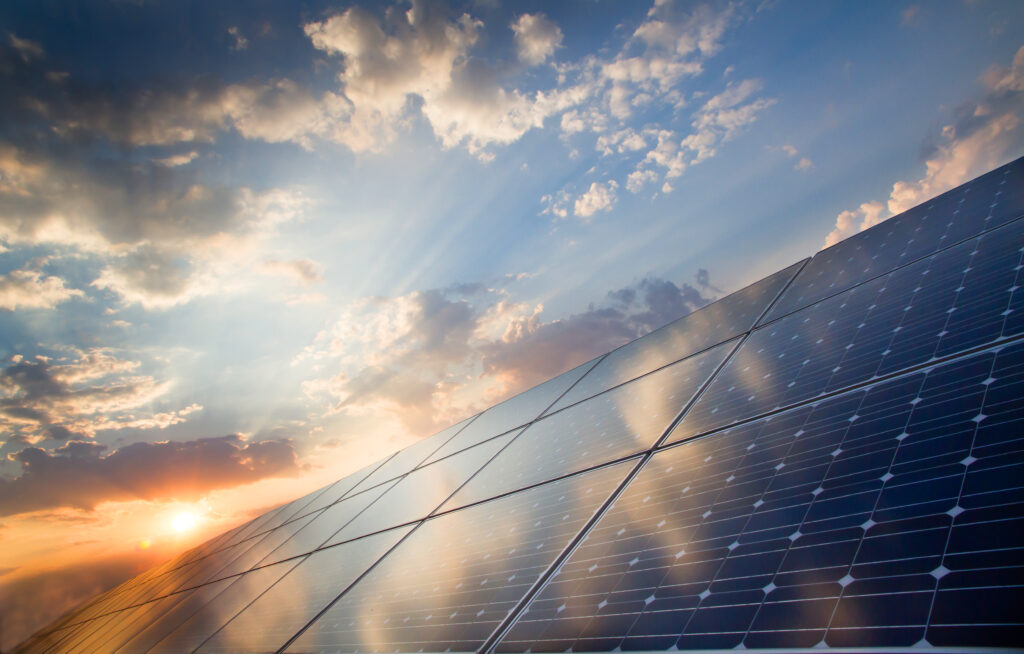Introduction
Solar panels are one of the most popular forms of generating energy for your business. However, many still wonder how much electricity a solar panel can produce. While a lot of this can be down to specific conditions and the type of solar panel used, there are some general criteria that can help give you a rough estimate
Solar Panel Output
Solar cell technology is increasing all the time. There are hundreds of types of solar modules on the market, while a 400w – 650w solar module would typically be specified for most commercial installations. Solar module sizes vary based on the number of internal cells, but a good rule of thumb for an average module is 1 meter wide by 2 meters tall, equating to 2 square meters per module.
How much energy do solar panels produce?
There are many factors that effect how much energy solar panels produce. All solar panels are rated on standard test conditions (STC). This is an industry-wide standard to indicate the performance of solar panels, they are tested in a lab at a cell temperature of 25°C, an irradiance of 1000 W/m2 with an air mass of 1.5. In reality, none of these test conditions are constant. Location, angle of the panels, orientation, shading, quality of components/installation and system maintenance will all effect how much electricity solar panels produce.
To accurately forecast solar generation, Energy Gain utilise industry leading, bankable software. This utilises local weather files that contain data on horizontal global irradiance, ambient temperature, horizontal diffuse, wind velocity along with key system component information to accurately predict system generation and better forecast annual returns. The final report will produce something called a solar yield. This is a figure that predicts how much electricity 1 KWp of solar panels will produce of over a year.
Example
1 KWp of solar panels installed on a south orientation, with a 20 degree pitch roof, installed correctly may generate circa 850 KWh per annum or units of electricity per year. This figure is known as solar yield and is expressed as (KWh/KWp).
200 KWp solar Photovoltaic system multiplied by 850 (solar yield) = The system is forecast to generate 170,000 KWh p/annum or units of electricity per year.
Energy Gain apply a rigorous engineering approach to all of our projects, starting with energy profiling and leading methodically through the system design, supply, project management, commissioning, verification, maintenance and monitoring.

How many solar panels will fit on my roof?
To get a rough estimate of the maximum number of solar modules and the system size you can fit on your business’s roof, measure the roof space (e.g., 20m x 80m) and divide the total area by 2. You will need to remove space for maintenance paths, fire breaks, vents and other existing roof furniture, along with 1m gap around the edge of each elevation. For a quick calculation remove 15-20% from your final calculation
Example
Available Roof Area: (20m x 80m = 1,600sqm) subtract 15% = 1,360 Sqm of suitable roof space
Suitable roof area 1,360sqm divide by 2sqm (module size) = 680 Solar Panels
680 Solar Panels multiplied by 400w = Delivers an approximate system size of 200 KWp for your business or factory.
Do solar panels produce a constant load?
No. Solar photovoltaic generation follows a daily and monthly bell curve. The measure of
energy per unit of area provided by the sun is called irradiance. Solar irradiance is effected by the time of day, year, cloud coverage and local weather conditions at a single point of
time. Solar generation typically follows the sun’s path and only operates during daylight hours.
Example
Using our
200 KWp solar panel installation the below shows a theoretical chart demonstrating
the breakdown of monthly generation.

How much do solar panels save?
Depending on your current business usage and working patterns, not all solar generation may be used to offset your electrical demand. For example, if you only have a working pattern of Monday – Friday, solar panels will still generate over the weekend. Your electrical demand maybe much lower than Monday – Friday and the solar panels may produce more electricity than your site uses, this will either be curtailed of exported to the grid.
A quick calculation on how much you can save is by multiplying the usable solar generation by your current electricity rate.
Example
The 200 KWp solar photovoltaic system is estimated to generate 170,000 KWh p/annum or units of electricity per year. Let’s assume the site will utilise 90% of the solar generation on site. Let’s also assume that you currently pay a rate of 27p p/kWh or 27p per unit of electricity from your current electricity supplier.
Forecasted Solar Generation 170,000 KWh p/annum multiplied by 90% = 153,000 KWh per annum of useable solar generation on site.
Year 1 savings equate to: 153,000 KWh (useable generation) multiplied by 27p per unit of electricity = £41,310 for year one.
In reality, there are a number of factors and parameters that will affect the whole life, financial business case and the decision to proceed with a project. Key variables include: the impact of electricity price fluctuations, system degradation over time, cost of finance, inflation, operation and maintenance costs/risks and business downtime.
Energy Gain use bespoke financial analysis software to complete a full financial assessment that includes, cashflow scenario modelling, review of funding mechanisms (CAPEX, Financing and Power Purchase Agreements), analysis of tax benefits and information surrounding local grants. A commitment to solar panels requires a long-term strategic view, EGUK only work with conservative estimates to provide realistic achievable ROIs that shareholders can support

Do solar panels reduce my carbon footprint?
Grid supplied electricity forms part of a business’s scope 2 to carbon emissions. The government publishes and updates greenhouse gas (ghg) conversion factors every year. As of 2023 the carbon emission factor for using 1 KWh of electricity purchased from the grid is 0.207 Kg CO2e. To calculate your businesses electrical carbon emissions, multiply your total annual electricity usage by 0.207.
As solar panels produce electricity direct from sunlight they have no carbon emissions. To calculate how much carbon they will save, simply multiply the solar panel systems’ usable solar generation by the current ghg conversion factor, as of 2023 this is 0.207 Kg CO2e.
Example
Solar panel useable generation is153,000 KWh p/annum multiplied by current ghg conversion factor as of 2023 this 0.207 Kg CO2e = carbon savings of 31,671 Kg CO2e per year. If you divide this by 1000 you will note it equates to circa 32 tonnes.
To put this into context a typical domestic house consumes 4,000 KWh p/annum with carbon emissions of 828 Kg Co2e. 1 year’s usable generation from the 200 KWp system is the equivalent of powering 38 houses for 1 year.
In the current climate, stakeholders urge environmental transparency, making carbon footprints a major focal point in many business strategies. Solar photovoltaics provide the ideal solution, supplementing your sustainable development strategy and boosting your CSR credentials.
Do solar panels require maintenance?
Energy
Gain offer a comprehensive solar panel monitoring and maintenance service to
ensure the solar panels continue to perform for the duration of their lifetime.
EGUK, deliver a range of O&M (Operations and Maintenance) services tailored
to your specific system needs.

Why choose Energy Gain to install your solar panels?
- Experienced energy consultants
- Market-leading financial modelling tools to allow scenario planning to strength test the business case
- Advanced modelling utilising local weather stations and system components to accurately forecast generation
- Strong balance sheet and trading history to support large scale projects
- Award winning construction and installation team.
- Review various system designs to balance capital costs with savings
- Strong customer references & testimonials with clients including SMEs to PLCs, such as Siemens, Goodwin, Watford FC and the Hyde group among 2,500 happy clients
- Only install Bloomberg NEF Tier 1 Solar Modules
- Proven quality ensures warranties are valid for system lifetime.
- Strong emphasis and proven track record on health and safety including insurance requirements.
- All of our installers are fully accredited, holding relevant CSCS and site safety cards.
- Best practice shared from operating in various sectors including: construction, manufacturing, heath and public sector.
Find out how solar photovoltaics can bring financial and environmental benefits to your business and book a free, bespoke and in-depth consultation: 01613307739


